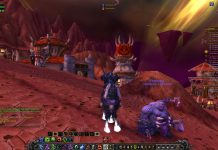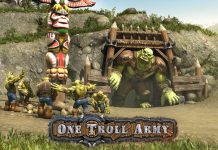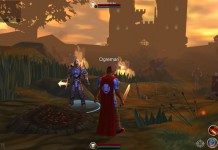The MMOTPS (related to MMOFPS except that its third-person rather than first-person) is a somewhat static genre filled with gun-toting commandos fighting their way through warzones and in a way it gave rise to the class-based shooter that’s no longer so first-person but still maintains that commando-attitude with games like Team Fortress 2. Changing that landscape, just slightly, Rock Hippo Productions—a publishing studio that also brought us MicroVolts—brings us the interesting divergence for the MMOTPS and trailing-cam class-based genre with their free-to-play Brawl Busters.
The game provides a lobby-based PvP-centric deathmatch-style game that also promotes some PvE content including a zombie-wave survival mode and a boss-battle. The classes in the games are called Busters and each provides their own strange set of talents and skills based on their class. Those five available classes are: The Rocker, the Blitzer, the Firefighter, the Boxer, and the Slugger.
The characters fight in colorfully vivid environments that are semi-destructible, receive random items from enemies and objects, and can interact somewhat with the maps.
Gameplay: Team Fortress 2 Meets Hand-to-Hand Combat with a Vengeance
For the most part, Brawl Busters isn’t about the MMOTPS shooting-and-going-commando style of gameplay—it’s fast, furious, and melee superpowers. Unless you’re playing the Slugger—chances are you’re going to be getting up close and personal with everyone you meet (although that can still happen to the Slugger, it’s just a primarily ranged class.)
There’s the five classes:
The Firefighter, while being the slowest class, Firefighters also do a lot of knockback by spraying a short range with a hose and also lob arced projectiles at enemies that explode on impact. They’re good at knocking people around (or off) ledges. Their special powers are about blocking people from reaching them or moving them around.
The Slugger, damage at long range with a small bit of melee combat, the quote here is “Sluggers are good at long range, but strike out at short range.” Very true, as Sluggers dictate a match by knocking multiple homing baseballs at incoming characters but can wind up for a slow home-run attack against melee range attackers with their first bat.
The Blitzer, keeping with the sports motif, this one is like playing a crazy line backer. Not too fast and not too slow, hauls along and throws punches with her ball and attacks by soaring through the air and touchdowning for massive AoE damage. I believe they also have high hit points.
The Boxer, blazingly fast but with low health, this class is all about hit-and-run. Their attacks are swift and disorienting and inflict massive damage in combination (assuming the opponent doesn’t get away first.) They move very quickly across the battlefield and can close distances in rapid order.
The Rocker, plays like a weird AoE hybrid melee striker. She swings with her guitar to pound opponents and can play chords that spray an AoE damage attack that also stuns and disorients for a time. Rockers are very good at dealing with groups of enemies with stuns and powerful point-blank AoE.
Players get to unlock more classes as they go along and each one is then available from then on.
Progression in the beginning can feel fairly quick, especially after running most of the tutorials to understand the classes. However, I quickly got stuck trying to grind up from level 4 to level 5. Fortunately, by that time you’ll have unlocked three classes so choosing wisely, you’ll have pretty much most of the classes you initially like under your belt and can switch between them. Plus, I was able to upgrade one of my weapons at least once (from my initial in-game currency.)
Playing PvE is a poor way to progresss up in the levels of this game, so team deathmatch will be where you are most of the time.
However, PvE does have two primary cooperative missions: Zombie Survival and Boss Battle.
Zombie Survival prevails upon four Busters to survive 4 or 7 rounds against increasingly tough waves of zombies. They pour in through the sides and chase down the players who must cut them down with their weapons and skills. Each round they get more numerous, healthier, and hit harder. Fortunately, downed friends can be resurrected by living friends.
The Boss Battle is the most amusing—but I haven’t won a single instance of this—where players are cooperatively asked to engage a single gigantic baddie who appears to be made of pink bubble-gum and wields a giant rolling pin. He’s called the “Crazy Cook” and is titled “Bubble Yum” in the game. He intermittently spawns horrible minions who must be defeated. Same as Zombie Survival, friendly players can be resurrected.
The “Crazy Cook” boss battle event ended January 30th; but it’s likely that there will be similar events to this cropping up again in Brawl Busters.
Graphics and Sound: Same sort of cell-shaded cartoon toy-like rendering from MicroVolts
Anyone who has played MicroVolts will instantly recognize the style of the characters and the maps, although unlike MV, Brawl Busters delivers life-sized maps that are streets, corridors, and buildings (whereas in MV is about children’s toys fighting one another.) The slick, plastic-look, and cartoonish cell shading is retained in the rendering but it does not retract from the gameplay.
When playing in an arena deathmatch the class of an enemy character is instantly visible upon seeing them as they all wear significantly obvious outfits. Each of the classes has a distinct weapon and look and this often gives you enough time to prepare yourself for the sort of attacks they’ll be delivering.
Attacks themselves all have fairly nice looking effects, mostly splashes and explosions. Hits are well-noted with graphical and UI elements.
The sounds is where Brawl Busters becomes quite hilarious.
The game likes to play with a sort of electric-guitar motif (possibly all a callback for the Rocker) and when hits are scored there’s a electric-guitar strum played, as hits are chained the tone of the strum increases.
When matches start there’s a cheering shout calling out the match beginning and then its just the background music and the sound of their attacks. Sometimes you can hear a crowd cheer or jeer when a game is won or lost but otherwise the sound is very simplistic. In PvE modes that involve zombies (which they all do) there’s also the groans and moans of the “dummy” characters as they come for you.
There seems to be only two songs and one of them plays all the time when in the lobby area waiting for a game to start.
Each character also has a basic animation that you end up watching a lot—such as the Blitzer rolling her hips back and forth and batting the football to spin it on her finger or the Rocker playing the air-piano as she waits to get going into the arena.
Freemium: Most weapons upgradable and purchasable for both currencies, some impermanent weapons
Rock Hippo runs Brawl Busters as a free-to-play game and they support it with a virtual item cash shop driven by microtransactions.
In the shop, players find a great deal of items that they can purchase with in-game currency. Amid these items happen to be a multitude of conventional aesthetic items, although many of them have a time-limit (and vanish) some of them convey stat boosts, but most do not. In some cases permanent versions are available for more money.
Weapon and armor upgrades are also available but are class agnostic—also the shop changes depending on which class the player has chosen at the time.
Much of the weapons in the shop are unavailable to new players and they must make it to the proper level to start using them. This sort of restriction feels a little odd with how slow it can be progressing from low levels to higher.
Conclusion: A noble class-based MMOTPS game with solid classes and an interesting melee component
After watching Brawl Busters played and watching the destructible environments—and comparing it to what I recall from MicroVolts—it seemed like a reasonably interesting game. There’s a lot going here, but I think most of the fun of this game will flow from unlocking and playing all the classes. I had trouble sticking with just one.
The US community (in US rookie and advanced) have quite a few games going on and people come into games consistently. Having only four-people on a team feels a little bit limited; but it makes for pretty quick runs (especially vs. Zombies) and it means there’s mostly 4v4 team deathmatch.
There’s an amusing amount of variety with the varied classes and learning to play one extremely well can become a challenge.
If you liked MicroVolts and you’re wondering what a game mostly about melee and strange environments; then you should try out Brawl Busters and see if it also tickles your fancy.



















Interesting looking game, great review!
Nice review! The game is also fun ^^
Heh, we should put together a GameOgre outing into Brawl Busters sometime and really surprise some group of players.
Solid MMO third person shooter game 🙂 I recommend it